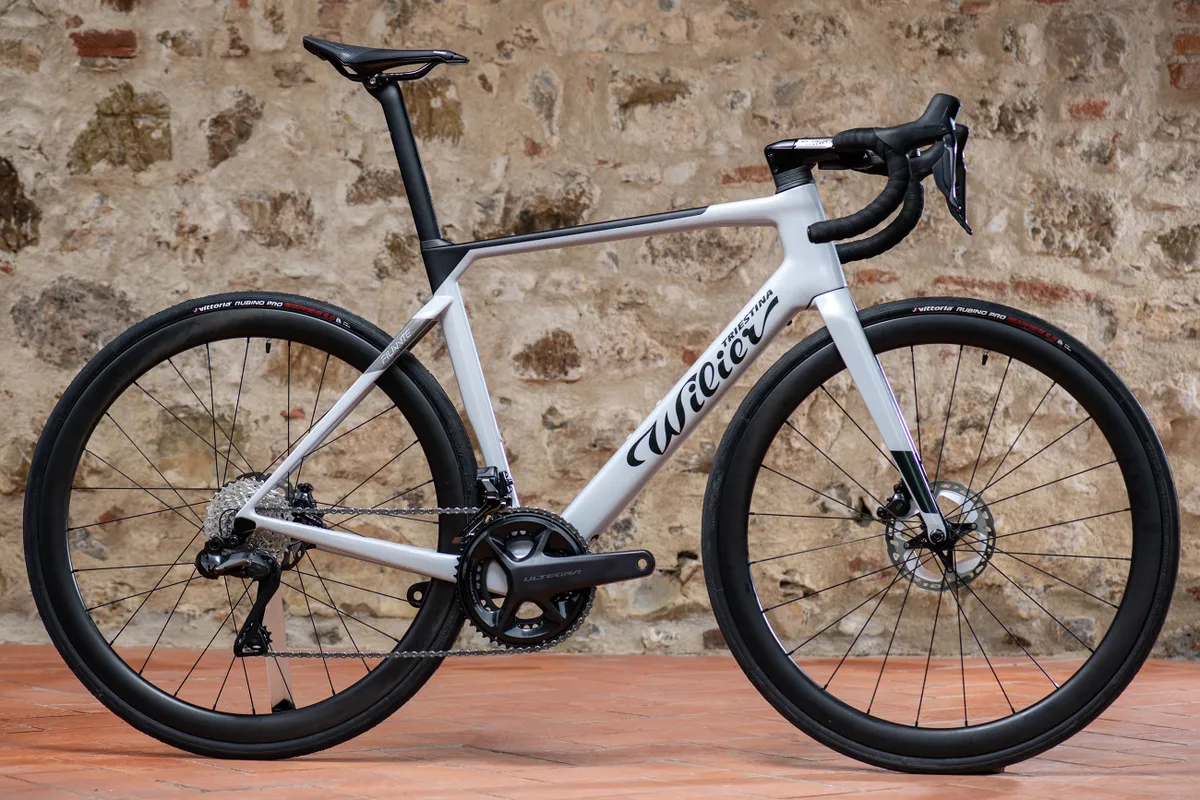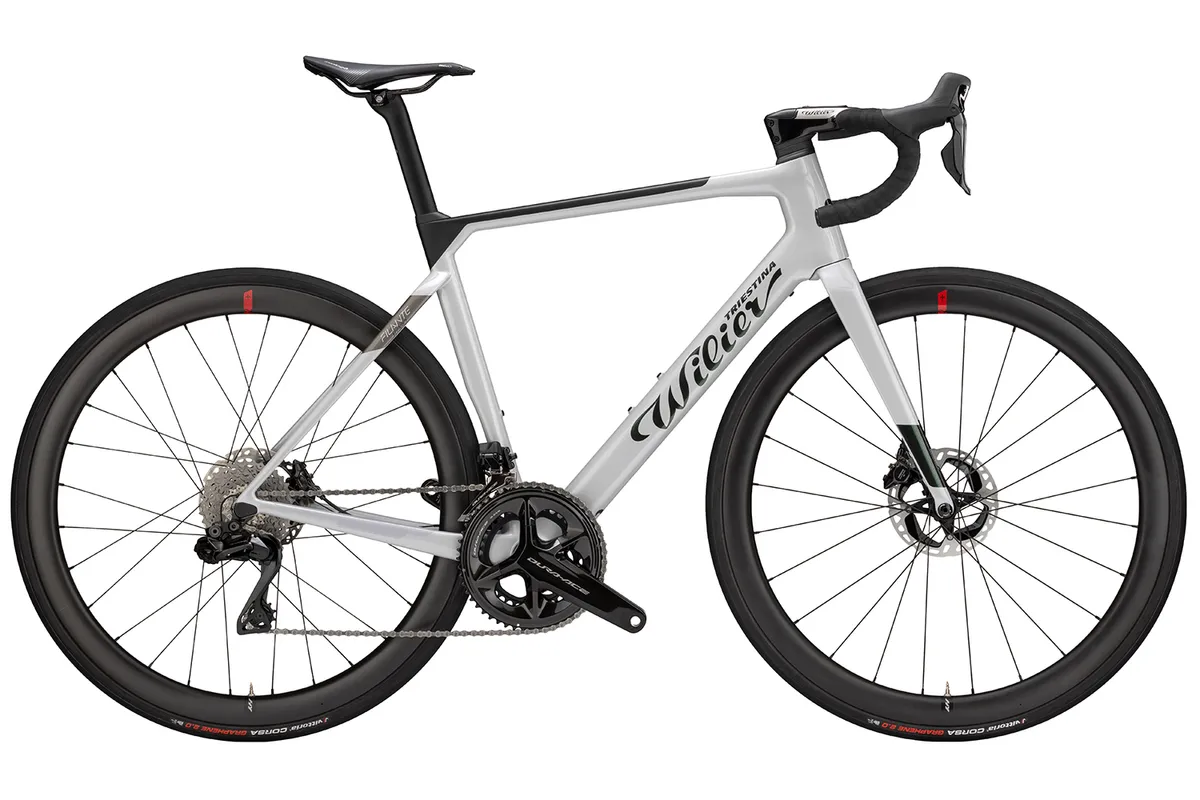Wilier has announced the release of the Filante Hybrid, a new electric road bike said to “help you go faster while minimising strain” and raise performance levels over the Wilier Triestina Cento10 Hybrid.
The bike has a new rear-hub motor and system called the X20 from German multinational company Mahle, which is said to be “driving technological innovation toward zero-impact mobility”, producing drive systems for a wide variety of vehicles.
Wilier claims the X20 is the lightest pedal-assist system in the world, with a claimed weight of 3.5kg for the complete system, which is 100g lighter than Mahle’s previous X35 motor system.
Wilier says it believes an electric bike should feel like a traditional road bike. To this end, the brand says it has optimised the Filante Hybrid for better aerodynamics and lighter weight, while commenting on how the new bike retains a resemblance to the Wilier Filante SLR superbike.
The two bikes don’t just have a resemblance in looks but in price too. The Filante Hybrid starts at £9,030 / €9,400 and extends to £11,990 / €12,300 for the top-tier version with SRAM Force AXS.
Mahle X20 motor system

Mahle’s rear-hub motors have appeared on Wilier’s previous electric road bikes, as well as on the Cannondale SuperSix EVO Neo 2 and the Scott Addict eRIDE Premium. This is, though, the first bike we’ve seen with the new X20 motor system.
At the heart of the Mahle X20 system is the rear-hub motor, which is said to deliver 60Nm of torque.
While many electric bikes use motors fitted at the bottom bracket, Wilier says having a rear-hub motor makes the most sense on an electric road bike because it gives the sensation of being pushed along.
The hub motor is built into Wilier rims with 24 spokes arranged in a straight-pull pattern.

Wilier says the motor is compatible with Shimano, SRAM and Campagnolo drive bodies, whereas the previous iteration of the Mahle system was compatible only with Shimano.
The motor is powered by a 250Wh battery, which is fitted in the down tube of the Filante Hybrid. There is a charging port for the battery at the bottom of the down tube.
This battery is said to provide power for up to 100km with 1,000m of climbing, which Wilier believes is suitable for the type of riding this bike will be used for.
Wilier says there will soon be an external battery pack, or ‘range extender’, available for the Filante Hybrid, which will provide an extra 185Wh of power. It will fit to the seat tube and come with a base for charging.

Previously, Wilier’s electric bikes relied on a pedal sensor to determine how much power was needed at a given moment. But the Filante Hybrid has a new bottom bracket with a torque and frequency sensor to better modulate the assistance provided by the motor.
Wilier says this system will help create a “natural pedalling experience with no jerks” and “deliver power smoothly even on steep inclines of over 10 per cent”, helping to create an experience that's closer to a non-assisted bicycle.
This power sensor is said to help optimise battery consumption because the power delivered is more proportionate to that delivered by the cyclist.

The motor system has four power modes – automatic, eco, sport and boost – which riders can flick through using the iWoc button fitted in the bike’s integrated stem.
On Wilier’s previous Cento1 Hybrid electric bike, the iWoc button was fitted in the top tube, and on the Cento10 Hybrid it was fitted on a bracket between the stem and bar.
Wilier says it decided to fit the iWoc button and its electronics in the stem of the integrated handlebar. This is so riders can operate the motor system without removing their hands from the handlebar, as well as seeing how much battery charge remains at a glance.
The integrated handlebar with the iWoc button is available in four sizes: 80mm, 90mm, 110mm and 125mm.
The Filante Hybrid comes with Mahle’s Pulsar One bike computer as standard. The computer has a 2.1in display that will show ride statistics and power output from the motor. It can be connected to other devices, such as power meters, via ANT .
Rear thru-axle

Wilier says that one of the key details of the Filante Hybrid is that the rear wheel with the Mahle X20 motor uses a thru-axle and can be removed, just like a standard thru-axle road bike wheel.
Speaking to BikeRadar, Wilier explained that typically rear-hub motors are held in place with nuts and bolts.
The system is said to connect to the battery automatically via a built-in electrical sensor, so there are no cables to be connected or disconnected by hand.
Wilier says the use of a thru-axle on the Filante Hybrid means riders can switch out the rear wheel for a standard bike wheel, turning the Filante into a standard, non-motorised road bike.
Wilier says the Filante Hybrid weighs roughly 10.3kg with Dura-Ace, but if you change the rear wheel for a standard road bike wheel, the weight will drop to about 8.3kg.
This is with the battery still in the frame, but remove that and the Filante Hybrid could become a sub-8kg road bike. However, when BikeRadar spoke to Wilier it advised against doing this because you would have to remove the bottom bracket to access the battery and disconnect it from the iWoc. It would then, of course, be tricky to reinstall.
A deceiving frameset?

Wilier says the Hybrid Filante’s geometry is similar to the brand’s endurance road bikes.
The bike has a 566mm stack and a 379mm reach in a size medium, which is the same as the Cento10 Hybrid, but more relaxed than the 538mm stack and 388mm reach of the Filante SLR.
Wilier says that although the bike has a “relaxed look”, the geometry “can be deceiving”. This is presumably meant to be interpreted as meaning the bike is faster and more responsive than these numbers would suggest.
The Filante Hybrid frameset might not share the same aggressive geometry as Wilier’s race bikes, but it does share the same frame material.
Like the Filante SLR and the brand’s Rave SLR gravel bike, the Filante Hybrid’s frame uses HUS-MOD carbon fibre mixed with liquid crystal polymers, which is said to create lightweight and reactive frames.
The Filante Hybrid also has the same aerodynamic carbon seatpost as the Filante SLR, and in superbike fashion, has all its cables and hoses routed internally.
The frame can fit tyres up to 32mm, which Wilier says is “suitable for a modern road bike”.
The popularity of electric road bikes
While an electric road bike with superbike pricing might leave some scratching their heads, electric road bikes are a huge market for Wilier, according to Francesco Munaron, Wilier’s PR and marketing specialist.
Speaking to BikeRadar, Munaron explains that the Cento1 Hybrid was the brand’s best-selling bike in 2018.
Wilier didn’t expect the bike to be as popular as it was, but its success led Wilier to think heavily about the electric road bike market and expand its production. Previously, Wilier had one production line, but it now has a second dedicated solely to electric road bikes, Munaron says.
Wilier Filante Hybrid geometry
| Size | XS | S | M | L | XL | XXL |
|---|---|---|---|---|---|---|
| Seat tube angle (degrees) | 74.5 | 74 | 73.5 | 73.5 | 73 | 72.5 |
| Head tube angle (degrees) | 71 | 71.5 | 72 | 72.5 | 72.5 | 72.5 |
| Chainstay (mm) | 406 | 406 | 408 | 408 | 411 | 411 |
| Top tube (mm) | 517 | 532 | 547 | 558 | 574 | 592 |
| Head tube (mm) | 117 | 136 | 157 | 177 | 196 | 217 |
| Wheelbase (mm) | 974 | 982 | 991 | 998 | 1,012 | 1,024 |
| Stack (mm) | 527 | 546 | 566 | 586 | 604 | 625 |
| Reach (mm) | 369 | 374 | 379 | 384 | 389 | 395 |
Wilier Filante Hybrid availability, prices and spec
The Wilier Filante Hybrid is available now in six builds and six sizes, from XS to XXL.
It is available with electronic groupsets only and either Shimano Dura-Ace Di2, SRAM Red AXS, Shimano Ultegra Di2, or SRAM Force AXS.
The Shimano Dura-Ace and SRAM Red AXS come with Wilier carbon wheels only, and the Ultegra and Force AXS builds come with either carbon or alloy wheels.
All models come with the Mahle X20 motor system. Full specs and international pricing are to be confirmed.
- Filante Hybrid with Dura-Ace Di2 R9270 and HY-SLR42KC carbon wheels: £11,800 / €12,300
- Filante Hybrid with SRAM Red AXS and HY-SLR42KC carbon wheels: £11,990 / €12,500
- Filante Hybrid with Ultegra Di2 R8170 and HY-SLR42KC carbon wheels: £9,890 / €10,300
- Filante Hybrid with Ultegra Di2 R8170 and HY-NDR28AC alloy wheels: £8,940 / €9,300
- Filante Hybrid with SRAM Force AXS and HY-SLR42KC carbon wheels: £9,990 / €10,400
- Filante Hybrid with SRAM Force AXS and HY-NDR28AC alloy wheels: £9,030 / €9,400


